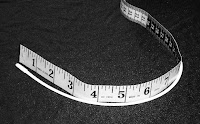Sunday, February 5, 2017
Anniversary Sale
Tuesday, August 19, 2008
Using Woven Fabrics
Woven fabrics may be used to make bra cups and straps. There are a few things that need to be considered when doing so. You need to have a good quality woven such as quilting cotton, tightly woven silk, or a tightly woven charmuese. These fabrics do not have stretch so they will need to be cut on the bias. Please note that there are 2 biases on a woven fabric and both need to be checked for amount of stretch.


Please note that there are 2 different biases. You will want to use the greatest stretch to layout your bra cups. Cut one set of upper cups as shown and cut 2 set of lower cups as shown. You will also need to cut a pair of straps, DO NOT CUT THESE ON THE BIAS.

The construction will remain the same as if making a bra from tricot.
Using Fashion Fabric
(New addition for the second edition of Intimately Yours)
There are two different options when using fashion fabric. The first option is to use the fashion fabric to cover the entire bra (bra cups, bra band and straps). The other option is to use the fashion fabric for only the bra cups and straps.
Option 1 – Fashion Fabric on whole bra
The components are now ready to be sewn together begin with Construction Step 1.
The components are now ready to be sewn together begin with ConstructionStep 1.
Side Support
Create a pattern piece using your bra band as shown. Make sure that you create a pattern piece that is ⅜” from the top of the bra band and ⅝” from the bottom of the bra band.
 Cut 4 from a stable fabric such as diaper flannel, firm broadcloth or lightweight Twill
Cut 4 from a stable fabric such as diaper flannel, firm broadcloth or lightweight TwillFuse 2 pieces together with a fusing material, such as Trans Web®, Stitch Witchery®, Steam-A-Seam® or Heat-n-Bond Light®. You now have 2 pads, 2 layers thick.
Place right side of stable fabric to wrong side of bra band as shown.
Unfinished edges will be caught as you finish the cup, upper edge and lower edge areas
Halo

A halo offers extremely soft breast tissue added support. Use a halo when a power bar and uplift are not enough support.
OUTERHALO
Using drafted upper and lower pattern pieces overlap ½” (note the dotted lines). Draft your outer halo pattern piece as shown with the solid lines. Please note the curve at the under arm is ⅜” in from the dotted line.

INNER HALO
Using drafted upper and lower pattern pieces overlap ½” (note the dotted lines). Draft your inner halo pattern piece as shown with the solid lines. Please note the curve at the neckline is ⅜” in from the dotted line.
Cut 4 of each of the diaper Flannel. Use Trans Web® or other fusible material and fuse together 2 of the inner and 2 of the outer halos. After fusing together merge them at the center using a wide narrow zigzag.
Outer edges can be zigzag basted together for ease of stitching to the bra (NOTE: serging will add unwanted thickness).
Bra cup halo is stitched to the bra just prior to the attaching Channeling Part 1.
Stitch bra cup halo to seam allowance ONLY of the lower cup seam. Place underarm corner and center front corner 3/8" below cup edges.
After stitching bra cups into band and BEFORE stitching channeling to cup/bra band seam allowance, stitch Halo to the seam allowance only of the cup/bra band. Be sure to measure ⅜” from the underarm cup and center front area to attach Halo (this must be done to reduce bulk).
Power Bar
Power Bar
 Cut 4 of flannel or other stable fabric. Using Trans Web® or other fusible material, fuse together 2 layers for each side. Serge or zigzag the edges.
Cut 4 of flannel or other stable fabric. Using Trans Web® or other fusible material, fuse together 2 layers for each side. Serge or zigzag the edges. After stitching bra cups into band and BEFORE stitching channeling to cup/bra band seam allowance, stitch Power Bar to the seam allowance only of the cup/bra band. Be sure to measure ⅜” from the underarm cup area to attach Power Bar (this must be done to reduce bulk).
The armhole part of the power bar does not get stitched into the upper bra cup/strap until Construction Step 11. Mark 1” down from the top of the strap on the upper cup, do not put the power bar top higher than this 1” mark. The power bar will be sandwiched between the tricot and the “fold over” of the plush elastic. Done properly the power bar will lay in smooth to the 1” mark line.
Problem: Bra band rolls up in center front
Shortening of Elastic
This will be done by measuring 3” from cup seam toward bra band back and stretching 2” of the upper elastic to fit that 3” area. Example: 15” – 1” = 14” meaning 2” of the remaining 14” will be stretched to fit the 3” band area
Stitching of Channeling
Construction Step 1 - Bra Cup Center Seam
(Insert on Page 25 first edition of Intimately Yours)
Layer these pieces in this order into 3 layer sandwich:












